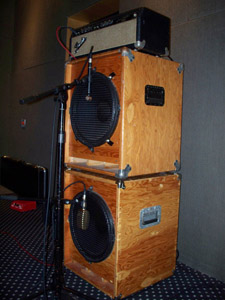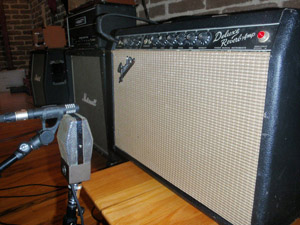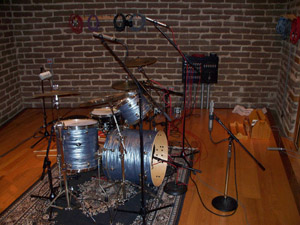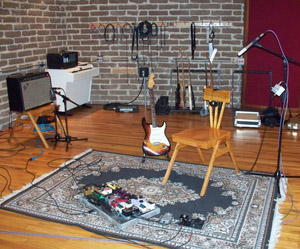How Grandfather Made a Record With Steve Albini in Three Days, Part II
[Part II of a three-part series. Read Part I here!]
After three months of non-stop work, rehearsing and raising money for our recording session, we left NYC for Chicago. During the 16-hour-long haul, we all felt an unbelievable sense of anticipation and excitement.
It had been a year since we began work on our debut record and in three days we would have a finished album. We were eager to get started.
DAY ONE: “Welcome to Electrical”
On Friday, July 16th 2010 at 10am sharp, we arrived at Electrical Audio. Greeted by a team of five interns, we began our tour of Studio A. As we walked through the tracking and control rooms, we could hear the echoes of our favorite records reflecting off the adobe brick walls. There was a vast musical history cemented into these walls, and soon enough we would become a part of it.
We immediately unpacked our gear, impatient to hear how the drums, bass and guitar would sound cranked up in the carefully constructed rooms.
The electric Fender bass was set up in a “dead” room called Alcatraz. The low end was transparently clear, and could be equally felt and heard. The electric guitar sounded ethereal in Center Field, as the live room’s high ceilings reflected feedback and fuzz, intensifying the natural dynamics of the amplifier. The drums, placed in the center of the smaller live room known as Kentucky, assaulted our senses with huge but focused reverberations.
It was a psychosomatic experience to play in the studio and hear the studio play back with us.
At noon, Steve Albini arrived in uniform. His custom Electrical Audio jumpsuit distinguished his role as the technician. The practical outfit reminded us of the engineers at Abbey Road Studios during the 1960s, who were required to wear suits during the sessions.
After a brief introduction and discussion of our strategy, we immediately got to work. Steve studied our equipment, and made a list of all the microphones and preamp combinations he would use to record our band (see detailed list below). Over the next hour, Steve meticulously set up microphones. In most studios, this menial task of setting up a session is often left to an assistant or intern, though Steve insisted that he do it all himself. His well-honed approach to capturing great sounds at the source became evident right off the bat.
Albini’s microphone technique was highly mix-conscious. His goal was to isolate the varying elements of the sound by using separate microphones.
For example, the guitar amp was captured using two different close proximity microphones, one that favored the lower frequency spectrum and the other more suited to capturing the high frequencies.
There was a third microphone placed on the floor in the middle of the room, about 20 feet from the amplifier to capture the ambient sounds and natural reverb of the room.
During the mix, rather than using an outboard processor for reverb, he could just turn up the fader on the ambient mic. If we wanted a stereo spread of the guitars, he could pan the two close mics left and right. Rather than using extra equalization to make the guitar darker or brighter, he could just alter the balance of the two microphones.
By 2pm, everything was set up properly, and the tape reels were calibrated. It was time to record.
“Gentlemen, You’re Rolling!”
Before each take, we would hear Steve in our headphones say, “Gentlemen, you’re rolling.” This would become a mantra for us, centering us for a few moments before we would unleash everything we had on our instruments.
Over the next 10 hours we would record guitar, bass and drums, live with no overdubs to all nine of our songs. The process itself was relatively simple, yet the scope of our work that day was immense.
We agreed that we would play each song in its entirety, only moving on once we were all satisfied with a single performance. We could not afford to waste tape by recording multiple versions of a song, or cutting up multiple performances into one take. This is where the months of strict rehearsal really paid off; we ended up using the first takes of five of the nine songs we recorded that day.
We were able to do this because we were less concerned with textbook mannered perfection and felt that a recording was only as good as the energy and emotion put into the performance. If we all felt good after completing a take, we knew it was a keeper, even before listening back.
This philosophy allowed us to complete the task at hand, and not fall prey to stifling over-analysis. This would never have been possible with the paralyzing influence our old home studio had on us. There was always more time, always a way to delete and start over — and at no cost.
Even though certain songs were completed in one take, others were not so easy. The physical duress of performing all day wore us down and at points we could barely play our instruments. We were forced to take a dinner break during the recording of our song “AWOL.”
My right hand became completely unresponsive and after four failed attempts at playing the frantic instrumental outro, we gave up and took a much-needed break.
Over dinner, we spoke about how despite our all our efforts to trust our instincts and carry out our plan, we really had no idea whether or not the session was going well or not. While we were making progress, we had relatively no time to listen thoroughly to the tracks. We were afraid to think too much, knowing that we didn’t have any time to second guess ourselves, or try something over. We just had to trust in Steve.
Whereas our energy and emotions would fluctuate throughout the day, Steve remained stoic the entire time, ready to man the board whenever we were ready to perform. He didn’t leave the studio once that day, not even to take a meal.
By midnight, we had successfully recorded full takes of eight of the nine songs. We were spent. We had poured everything we had — physically and emotionally — into the music that day. We decided to save the final song for the morning. With two more 12-hour workdays ahead of us, we hit the sack and passed out immediately.
— Michael Kirsch, Guitarist, Grandfather
You can download Why I’d Try for FREE on our website: http://grandfathermusic.com. Email any questions to info at grandfathermusic dot com
GRANDFATHER SESSION NOTES:
All mics through Neotek desk preamp except as noted
Drums (Kentucky)
Bass Drum Front: Beyer M380 -> 1176 Limiter Slow Release, 20:1
Bass Drum Batter: Shure SM98
Snare: Sony C37e -> NTI EQ
Rack Tom: Josephson E22s Top and Bottom
Floor Tom: Josephson E22s Top and Bottom
Overheads: Royer 122 (L&R) -> 1178 Limiter -> GML EQ + 678k + 3726k
M-S Stereo: AKG C24 M.S (0 + ∞) -> Electrical M-S Matrix
Room Ambience: Neumann CMV563 + N55k Capsules (L&R) -> 20ms Stereo Delay
Rimshot: Shure SM98 -> GML Limiter
Bass Guitar (Alcatraz)
Low: Beyer M380 -> Urei LA12 Limiter “Auto” – 3dB
High: Josephson E22s -> John Hardy M2 Preamp -> HPF 280Hz
Electric Guitar (Center Field)
Low: RCA74 (“Junior Velocity”) -> GML Preamp
High: Audio Technica Pro37 -> GML Preamp
Room Ambience: Crown PCC
Vocal (Kentucky facing Center Field)
Main: Neumann U48 -> John Hardy M2 Preamp -> 1176 Fast Release 20:1
Vocal Ambience: Crown PCC -> Expander Keyed to Vocal Mic
For more information on Electrical Audio’s Rooms and Equipment, visit http://www.electrical.com.
Click for more Grandfather Session Photos and Grandfather’s equipment list.












Defusedclock
October 5, 2010 at 5:37 pm (14 years ago)This series is really illuminating! Honest, direct and very well done!
Jon
October 12, 2010 at 5:17 am (14 years ago)really interesting how albini is using such heavy compression on things (20:1 on kick and vox) before he even hits the tape. go big or go home, as they say.